Fred's Parents
George Frederick Hill DCM (b1877 - d1941)
George Frederick Hill was born on 12 December 1877 at North Gate, Bridgwater, Somerset, the fifth child and only son of Robert Hill and Jane Hill (Stone). He was baptised in the parish of Bridgwater on 29 September 1880. He had four older and one younger sisters: Florence Jane (b1866 - d1894), Ada Eliza (b1869 - d1926), Clara Louise (b1873), Beatrice Ellen (b1875 - d1961) and Agnes Maud Mary (b1880 - d1951).
In 1881 the family, excluding oldest sister Florence, were living at Golds Buildings, Bridgwater. Robert Hill worked as a bargeman and the older daughters were at school.
In 1891 the family were living at North Gate, Bridgwater. Robert was a general labourer, Clara was a scale polisher, George was an errand boy and Agnes was at school.
On 29 May 1898 George married Ellen Merrick, at the Parish Church of Holy Trinity, Bridgwater. Ellen’s age was given as 18, although she had only just turned 16, having been born on 15 May 1882. She was also about 2 months pregnant. George was a labourer and he and Ellen were living at Albert Street, Bridgwater. Present at the wedding were George’s sister Beatrice Ellen and her future husband Samuel Squire.
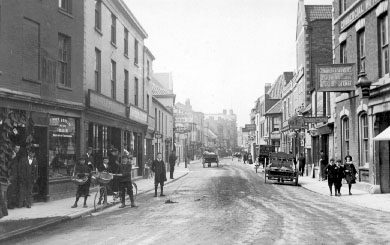
Eastover, Bridgwater
George and Ellen’s first child, Florence Ellen was born on 10 December 1898 when the couple were living at 2 Roberts Court, Eastover, Bridgwater. She was baptised on 6 January. Son Robert Baden was born on 24 November 1900 when they were living at 7 Court, Anstice Place, Eastover, Bridgwater. He was baptised on 21 December. They were living there at the time of the 1901 census with George age 23 a general labourer, Ellen age 21, daughter Florence E age 2 and son Robert B age 4 months. Both children died within three weeks of each other in early 1903. Florence died on 20 January from meningitis and measles and was buried on 24 January at Wembdon Road Cemetery, Bridgwater. Robert died on 6 February from broncho pneumonia and measles and was buried on 14 February at Wembdon Road Cemetery, Bridgwater. The family were living at Moat Lane, Bridgwater at the time. It is not known what happened to Ellen. George registered the deaths of both children but a record of Ellen’s death has not been found.
At the time of the 1911 Census, on 2 April, he was a lodger at 12 Pontllan Huts, Llangyfelach, Swansea with Samuel Lilley and his wife plus seven other lodgers, all involved in railway construction. George was a labourer, 33 years old and a widower.
George joined the Special Reserve before the start of the First World War. The Special Reserve was a form of part-time military service. Special Reservists enlisted for 6 years and had to accept the possibility of being called up in the event of a general mobilisation and to undergo all the same conditions as men of the Army Reserve. Their period as a Special Reservist started with six months full-time training (paid the same as a regular) and they had 3-4 weeks training per year thereafter. A man could extend his SR service by up to four year, but could not serve beyond the age of 40.
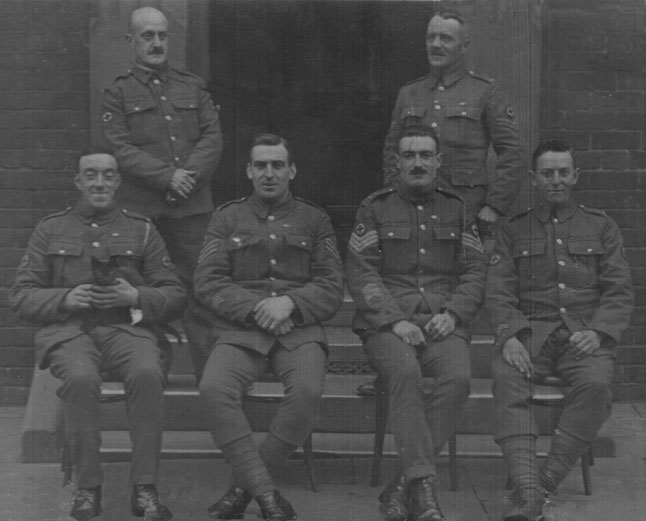
Members of the RAMC before leaving for France, 1914. George is back row, right
As Private 641 George Hill, 7th Field Ambulance, Royal Army Medical Corp. he was part of the 3rd Division of the First British Expeditionary Force which arrived in France on 18 August 1914. One of the first Divisions to move to France, the 3rd Division remained on the Western Front throughout the war. It took part in most of the major actions. Led by Sir John French, they withstood the German onslaught at Mons, The Marne, The Aisne and Ypres, and by keeping the enemy from the Channel Ports, saved England from invasion. They derive their honourable title 'The Old Contemptibles' from the famous "Order of the Day" given by the Kaiser, Wilhelm II, at his headquarters, Aix-la-Chappelle, on the 19 August, 1914:- "It is my Royal and Imperial Command that you concentrate your energies, for the immediate present, upon one single purpose and that is that you address all your skill and all the valour of my soldiers to exterminate first the treacherous English, walk over General French's contemptible little Army."
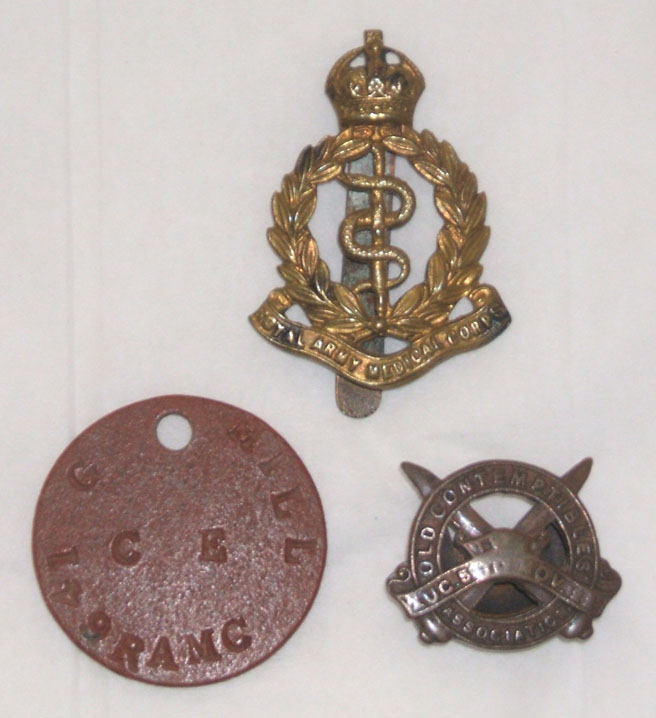
George's Badges and Dog Tag
The Field Ambulance was part of the casualty evacuation chain. It was under the command of the Division, and was attached to a Brigade. The Field Ambulance provided one or more Advanced Dressing Stations in reasonable proximity of the front lines. The Field Ambulance played a very critical role, as it received men soon after they had received their wound. If it was possible, a wounded man would first be treated at a Regimental Aid Post, a small and often temporary position near or in the front lines. Here a Medical Officer of the RAMC, with 2 RAMC orderlies and a number of stretcher bearers (who were not RAMC men, but from units of the Division) would carry out first-aid. This might be sufficient treatment to allow the man to carry on (in the event of superficial cuts for example), or in other cases be something to enable him to pass to the next stage, the Field Ambulance. The Field Ambulance would attempt to treat the man, or again just do enough to ensure he could be passed back to the next point, the Casualty Clearing Station (CCS). The theoretical capacity of the Field Ambulance was 150 casualties, but in battle many would simply be overwhelmed by numbers. The Ambulance was responsible for a number of points along the evacuation chain for the casualty, from the Bearer Relay Posts up to 600 yards behind the Regimental Aid Posts, through the Advanced Dressing Station (ADS), to the Main Dressing Station (MDS). It also provided a Walking Wounded Collecting Station, as well as various rest areas and local sick rooms. The Ambulances would usually establish 1 ADS per Brigade, and 1 MDS for the Division. The Field Ambulances saw the full horror of war casualties: the cemeteries on and behind the battlefields mark the location of many of them, and of the CCSs.In November 1914, an advertisement was placed in the national press inviting monetary contributions to a 'Sailors & Soldiers Christmas Fund' which had been created by Princess Mary, the seventeen year old daughter of King George V and Queen Mary. The purpose was to provide everyone wearing the King's uniform and serving overseas on Christmas Day 1914 with a 'gift from the nation'. The response was overwhelming, and it was decided to spend the money on an embossed brass box. The contents varied considerably; officers and men on active service afloat or at the front received a box containing a combination of pipe, lighter, 1 oz of tobacco and twenty cigarettes in distinctive yellow monogrammed wrappers.
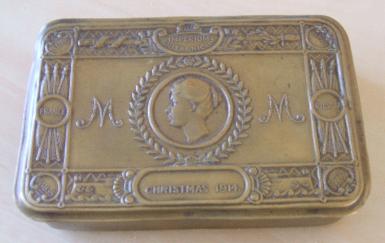
George's 1914 Christmas Gift Box
George was awarded the Distinguished Conduct Medal, second only to the Victoria Cross for NCOs and other ranks, during the Battle of Neuve Chapelle which was fought between 10-13 March 1915 and which was originally intended to comprise part of a wider Allied offensive in the Artois region. 7,000 British troops died in that battle alone.
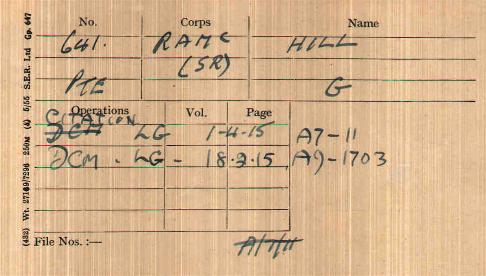
George's Medal Record Card - DCM
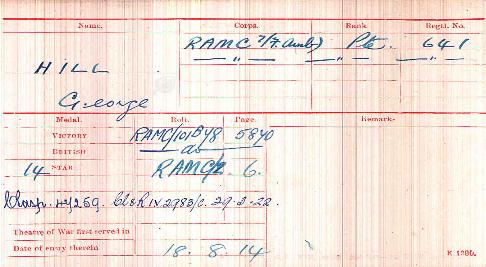
George's Medal Record Card - Campaign Medals
His Citation, published in The London Gazette of 1 April 1915, reads: 'For gallant conduct on many occasions, especially at Neuve Chapelle, where he showed a fine example of devotion to duty in leading stretcher bearers under fire.'
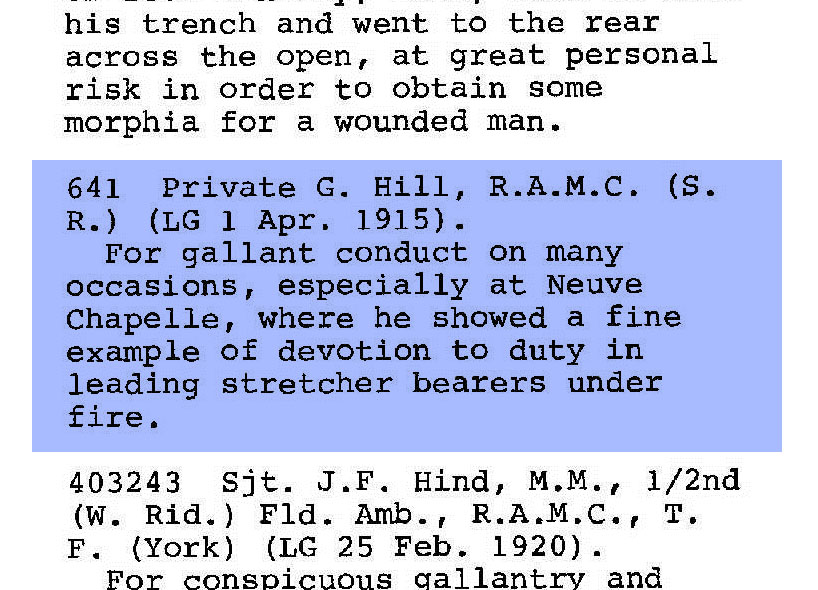
Citation
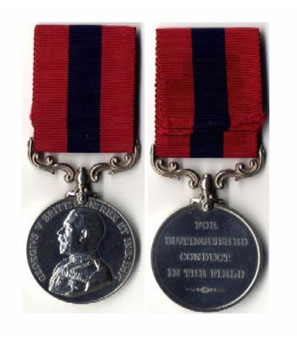
Distinguished Conduct Medal
He was also awarded the three campaign medals: the 1914 'Mons' Star, the Victory medal and the British War medal.
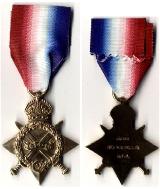
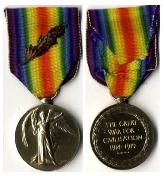

1914 'Mons' Star Victory Medal British War Medal
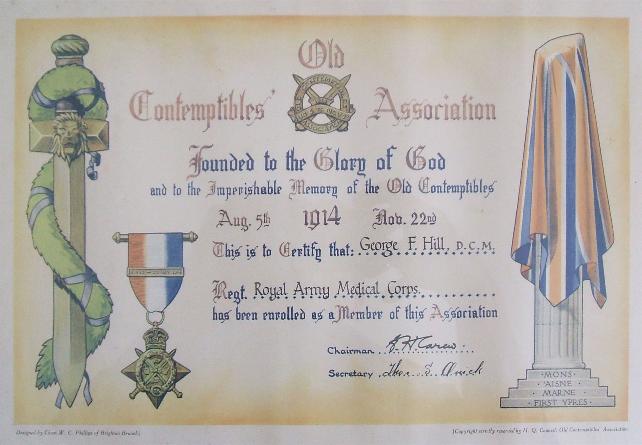
Certificate of Membership of Old Contemptibles Association
After service in France, George was sent to Mesopotamia, what is now modern day Iraq, for the remainder of the war.
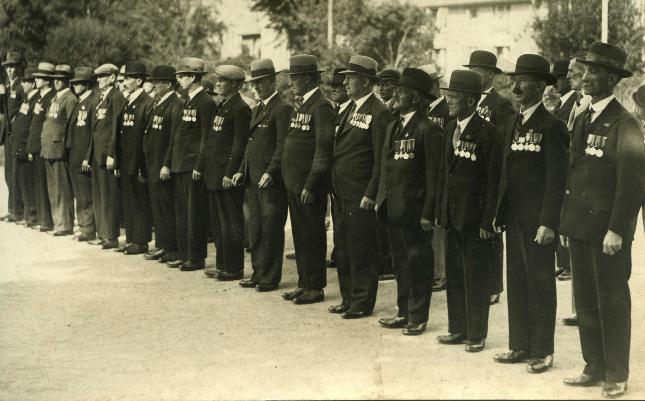
Soldiers on parade, c1920. George is fourth from right
After war ended, George returned to Somerset and got his cousin Beatrice pregnant. They married on 13 September 1919 at the parish church of St Mary Magdalene, Taunton. Present as witnesses were Beatrices's father James and Bessie Stambrook. George was living at High Street and Beatrice at Tangier at the time.
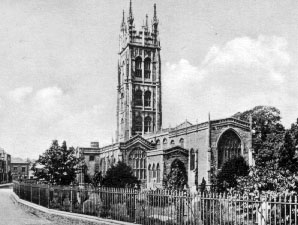
St Mary Magdalene Church, Taunton
Their first child Fred was born on 16 January 1920 at 3 Tangier Cottages. Daughters Kathleen May was born on 21 May 1921, and Dorothy Jane on 15 October 1923. Son Leslie James was born on 9 January 1925. Kathleen died on 27 July 1925 from whooping cough, age 4 years. Son Stanley Norman was born on 24 January 1926 and died just 12 days later, on 5 February 1926 from severe malnutrition. Leslie died on 16 May 1926 from broncho pneumonia, age 16 months.
It is hardly surprising that three of George's children died in infancy. The family were living at 3 Tangier Cottages, a two up, two down back-to-back terraced house with no running water or sanitation. Water had to be drawn from a standpipe outside a house further down the terrace, the toilets were in a communal block, and having a bath necessitated a trip to the public bathhouse.
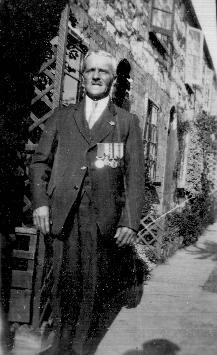
George Frederick Hill outside 3 Tangiers Cottages, c19??
The family did not move to 57 Wood Street until about 1930. This was a larger three bedroom mid terraced house which had running water and an outside toilet, but no bathroom. Bathing still required a trip to the public bathhouse.

Old Contemptibles Association, Taunton Branch, Remembrance Service, August 1933. George is back row, fourth from left
George spent the rest of his working life as a labourer at Taunton Gas Company which was adjacent to Tangier. He died on 15 January 1941 age 63 years from lung cancer, having been ill for some time. He was buried at St Mary Magdalene and Bishops Hull Cemetery following a funeral service at St Mary's Church attended by senior management of Taunton Gas Company and members of the Royal British Legion.
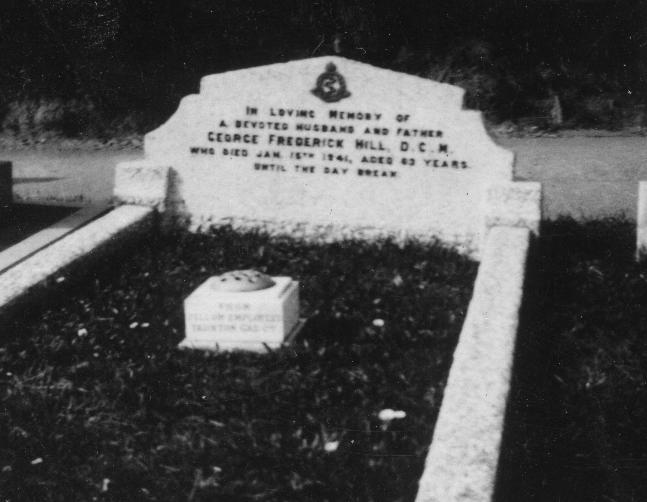
George's grave, St Mary Magdalene and Bishops Hull Cemetery. The insription reads: 'IN LOVING MEMORY OF A DEVOTED HUSBAND AND FATHER GEORGE FREDERICK HILL, D.C.M. WHO DIED JAN 15th 1941, AGED 63 YEARS. UNTIL THE DAY BREAK'
The inscription on the flower holder reads: 'FROM FELLOW EMPLOYEES TAUNTON GAS CO'
Beatrice Kate Hill (b1881 - d1968)
Beatrice Kate Hill was born on 31 December 1881 at 3 Tangier, Bishops Hull, Taunton, Somerset, the second child and only daughter of James Hill and Jane Hill (Parkhouse). She was baptised at St John Taunton on 8 March 1882. She had an older brother Frederick George (b1870 - d1937).
In 1891 the family were living at 3 Tangier and James worked as a stoker, Frederick was a carpenter and Beatrice was at school. Also living with them were George and Rose Parkhouse, Jane’s nephew and niece.
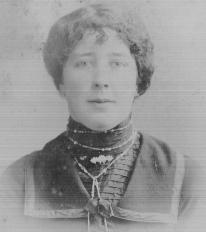
Beatrice c1900
In 1901, the family were still living at 3 Tangier, with James working as a gas stoker and Beatrice as a dressmaker. Frederick had left home and got married.

Beatrice c1905
Beatrice's son, Robert John, was born on 3 May 1908 at 3 Tangier. No father was indicated on the birth certificate. In 1911 Beatrice and Robert were living with her cousin William Parkhouse and his wife Emily and their five daughters at Bawdrip near Bridgwater. William's occupation is given as market gardener and Beatrice's as a dressmaker. Daughter Cecilia Beatrice was born on 13 December 1912 at 3 Tangier. Again, no father was indicated on the birth certificate.

Beatrice and George c1918
Beatrice married her cousin George on 13 September 1919 when she was about 5 months pregnant with their first child Frederick George, who was born on 16 January 1920 at 3 Tangier Cottages. Daughters Kathleen May was born on 21 May 1921, and Dorothy Jane on 15 October 1923. Son Leslie James was born on 9 January 1925. Kathleen died on 27 July 1925 from whooping cough, age 4 years. Son Stanley Norman was born on 24 January 1926 and died just 12 days later, on 5 February 1926 from severe malnutrition. Leslie died on 16 May 1926 from broncho pneumonia, age 16 months. George is named as the father on the birth certificates of all their five children.
It is hardly surprising that three of their children died in infancy. The family were living at 3 Tangier Cottages, a two up, two down back-to-back terraced house with no running water or sanitation. Water had to be drawn from a standpipe outside a house further down the terrace, the toilets were in a communal block, and having a bath necessitated a trip to the public bathhouse.
The family did not move to 57 Wood Street until about 1930. This was a larger three bedroom mid terraced house which had running water and an outside toilet, but no bathroom. Bathing still required a trip to the public bathhouse.
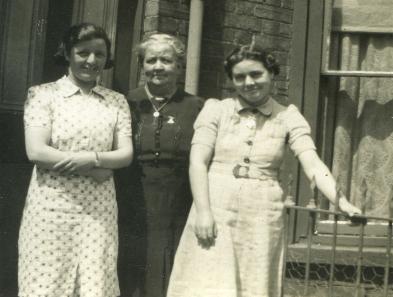
Beatrice with daughters Cecilia and Dorothy, c1940
Beatrice was living at 57 Wood Street when George died in 1941. After Fred and Dorothy left home and married, Beatrice continued living there with Cis, who did not marry, until the time of her death.

Beatrice outside 57 Wood Street, 1965
Beatrice died on 22 June 1968 age 86 years, from heart disease, and was buried with George at St Mary Magdalene and Bishops Hull Cemetery.
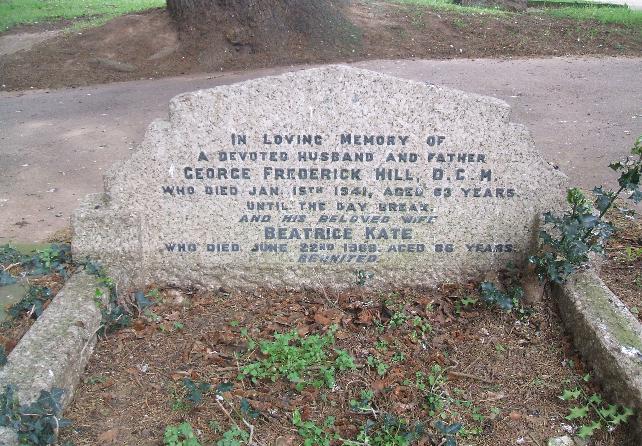
George and Beatrice's gravestone, St Mary Magdalene and Bishops Hull Cemetery
Go to top